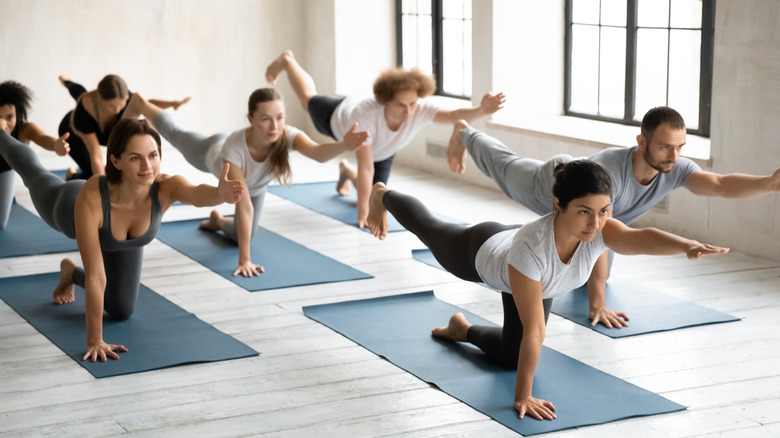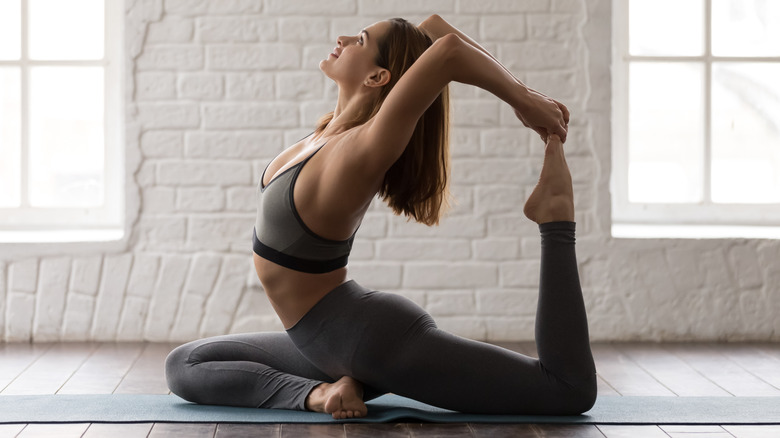Here's How To Start A Career As A Yoga Instructor
Yoga benefits both the mind and body, making it easier to cope with stress and overcome day-to-day challenges. In the long run, it can improve your balance and flexibility, reduce lower back pain, and ease arthritis symptoms, notes Johns Hopkins Medicine.
Given these benefits, it's no surprise that more than 300 million people practice this centuries-old discipline. If you've been doing yoga for a while, you could go one step further and share your knowledge with others.
Charles Matkin, Jason Crandell, Monique Schubert, Simon Park, and other famous yoga teachers have millions of fans. Their work has changed lives, helping people find their inner balance and thrive.
"I want my students to be really curious about who they are and to be accepting of whoever that may be on a particular day," Vinyasa yoga teacher Jason Crandell told Yoga Journal. "I want them to see that everything inside and outside is incredibly mysterious. I want them to use the practice to just check in, see what's unfolding, and learn to deal with it skillfully."
You, too, can become a yoga instructor and make a difference through your work. But, first, take some time to study this discipline and the different styles of yoga. There's Hatha yoga, yin yoga, Ashtanga, Vinyasa, aerial yoga, and others. Some emphasize meditation and deep breathing, while others focus on physical exercise.
Yoga teachers have in-depth knowledge of these concepts and use their skills to help get started, improve their practice, or reach specific health goals.
Choose a style of yoga that suits you
Yoga has been around since 2700 B.C., evolving into different forms over the centuries. For example, Ashtanga and Bikram yoga are more physically demanding than Integral Yoga, which emphasizes deep relaxation, chanting, meditation, and mindfulness.
Iyengar yoga focuses on proper body alignment, helping practitioners improve their strength and flexibility. Kundalini, on the other hand, encompasses meditation, deep breathing, and spiritual practices, such as repeating mantras to awaken your inner energy, explains Yoga Journal.
As a yoga instructor, you can specialize in one or more practices, but it's best to choose a few that are somehow connected. Think about your experience, fitness level, lifestyle, and target audience, among other factors. If you plan to work with novice practitioners, it makes sense to choose a gentler style of yoga, such as Hatha, Iyengar, or Viniyoga, notes WebMD. Alternatively, you may teach prenatal yoga or couples yoga.
Research the local market to see what other instructors are offering. Try to come up with something new or different, but consider your lifestyle and personal preferences, too. Determine whether you want to teach online or in person and how much you can afford to spend on yoga training, props, and other resources.
Hatha yoga, for instance, requires 200 to 300 training hours, which can pose challenges for aspiring teachers who are still in school or working a nine-to-five job.
Complete a training program
Yoga instructors are not required to hold a certification, but having one demonstrates your commitment to the profession and can make it easier to find work. Ideally, choose a school registered with the Yoga Alliance, a nonprofit that regulates this profession in the U.S. Yoga Alliance offers six levels of certification based on the candidate's experience and the number of training hours completed.
For example, those who complete 200 hours of training can apply for certification as a Registered Yoga Teacher (RYT) 200. There's also the option to become a Registered Prenatal Yoga Teacher (RPYT) or Registered Children's Yoga Teacher (RCYT) following the completion of a 200-hour program plus specialized training.
Yoga Alliance members must also take continuing education courses every three years and pay an annual fee. As a member, you'll have access to special discounts, educational resources, exclusive events, and networking opportunities.
The organization provides a list of schools that meet its requirements, so you might want to check it out. Peachtree Yoga Center in Atlanta, for instance, offers two certification programs covering human anatomy, yoga philosophy, breathing techniques, and other related aspects. Later, instructors can specialize in different types of yoga to grow their practice and reach a wider audience.
Also, note that health and fitness centers may require trainers, including those who teach yoga, to obtain CPR (cardiopulmonary resuscitation) and first aid certification, according to the Bureau of Labor Statistics.
Getting started as a yoga instructor
As of October 2021, there were over 40,582 Pilates and yoga studios in the U.S. alone. This industry is extremely competitive, with new studios popping up each year.
If you're just starting your career, seek ways to stand out from the crowd and make a name for yourself. First, apply for jobs at local yoga studios or gym chains to gain experience and build a customer base. For example, Core Power Yoga has more than 200 studios across the U.S., and its staff receives a comprehensive 401(k) plan, health coverage, paid time off, and other perks.
Meanwhile, you could set up a website or blog to promote your services. Publish articles and videos, share your favorite yoga poses, and address customers' pain points. Leverage social media to connect with potential clients and share your expertise.
Alternatively, you may offer yoga classes on your website, YouTube, Zoom, or dedicated platforms like Union and Yogi Approved. Another option is to set up a live stream on Marvelous or Uscreen or create and sell yoga courses on Thinkific, Teachable, or Udemy.
Yoga instructors can also open their own studios and work with local clients. However, this may not be the best option for those living in a small city or one with an oversaturated market.
As far as salary goes, the average yoga teacher makes around $77,000 per year, but it's possible to earn more — especially if you run your own business.



